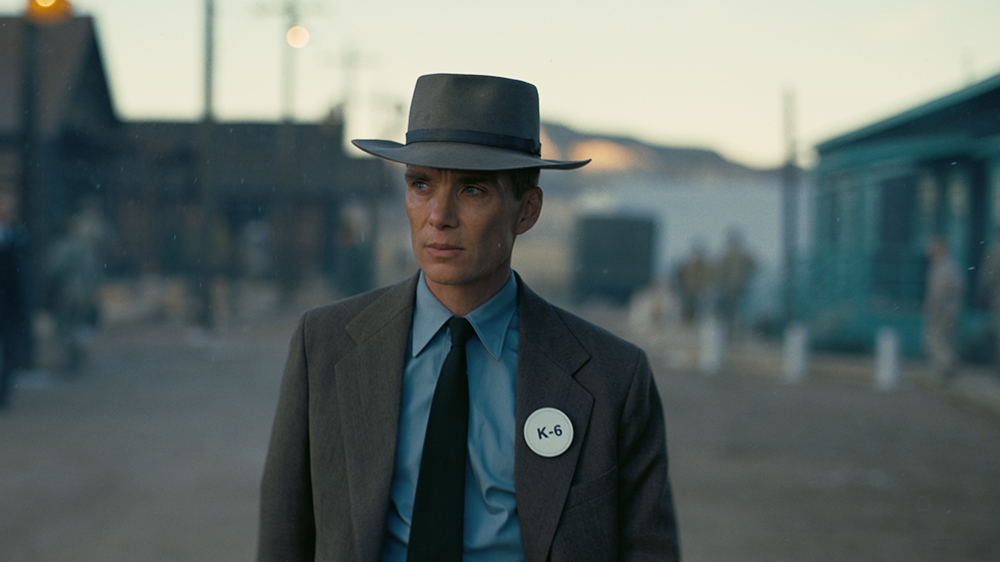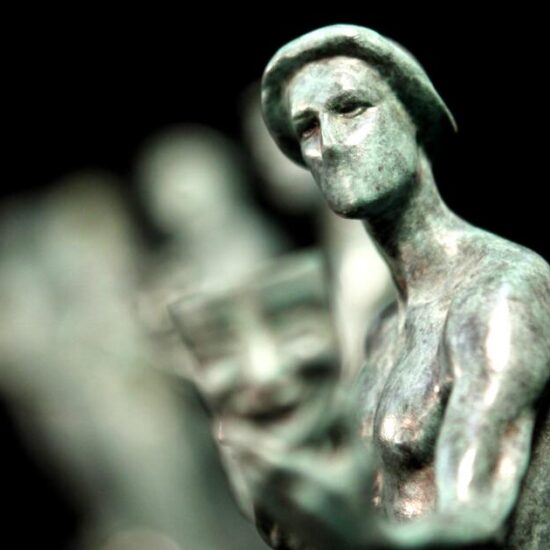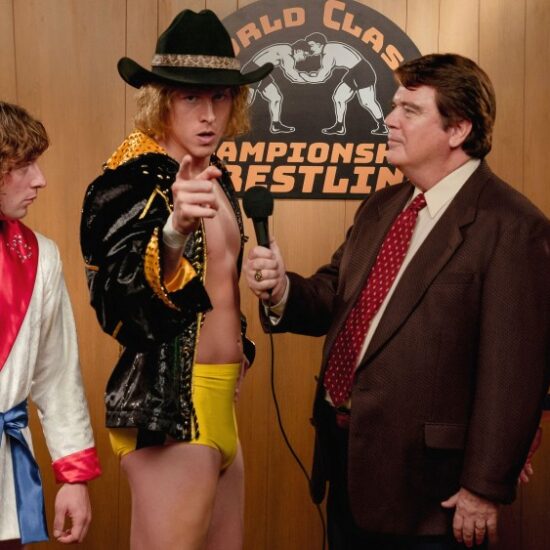
In the early scenes of “Oppenheimer,” J. Robert Oppenheimer (Cillian Murphy), an American physics student attending graduate school in England and Germany in the 1920s, with bright blue marble eyes and a curly wedge of hair that stands up like Charlie Chaplin’s, keeps having visions of particles and waves. We see the images that are disrupting his mind, the particles pulsating, the waves aglow in vibratory bands of light. Oppenheimer can see the brave new world of quantum mechanics, and the visual razzmatazz is exactly the sort of thing you’d expect from a biopic written and directed by Christopher Nolan: a molecular light show as a reflection of the hero’s inner spirit.
But even when “Oppenheimer” settles down into a more realistic, less phantasmagorical groove (which it does fairly quickly), it remains every inch a Nolan film. You feel that in the heady, dense, dizzying way it slices and dices chronology, psychodrama, scientific inquiry, political backstabbing, and history written with lightning — no mere metaphor in this case, since the movie, which tells the story of the man who created the atomic bomb, feels almost like it’s about the invention of lightning.
Cillian Murphy, with a thousand-yard beam, the half-smile of an intellectual rake, and a way of keeping everything close to the vest, gives a phenomenal performance as Oppenheimer, making him fascinating and multi-layered. His “Oppie” is an elegant mandarin who’s also a bit snakelike — at once a cold prodigy and an ardent humanist, an aristocrat and a womanizer, a Jewish outsider who becomes a consummate insider, and a man who oversees the invention of nuclear weapons without a shred of doubt or compunction, only to confront the world he created from behind a defensive shield of guilt that’s a lot less self-aware.
Murphy, wearing Oppenheimer’s trademark wide-brimmed porkpie hat (or sometimes wearing nothing at all, a shock because we’re not used to seeing a science geek portrayed with this kind of sensuality), is at the center of almost every scene, and he imprints himself on your imagination. The movie needs that, because “Oppenheimer” is a relentless, coruscating piece of maximalist cinema that you watch on the edge of your brain. Nuclear fission means the release of energy that happens when the nucleus of an atom is split, and Nolan has conceived “Oppenheimer” as an act of cinematic fission. He fragments the story into parts that keep colliding, immersing us in the heat and energy that all gives off. It’s a style that owes a major debt to Oliver Stone’s “Nixon,” though that movie was a masterpiece. This one is urgent and essential, but in a less fully realized way.
It opens with a flash forward to the 1954 hearing of the U.S. Atomic Energy Commission that ultimately resulted in Oppenheimer, accused (among other things) of having hidden Communist ties, being stripped of his security clearance. This was the government’s way of silencing him, since in the postwar world he’d become a something of a dove on the issue of nuclear weapons, a view that didn’t mesh with America’s Cold War stance of aggression. The hearing was the darkest chapter of Oppenheimer’s life, and using it as a framing device feels, at first, like a very standard thing to do.
Except that the film keeps returning to the hearing, weaving it deep into the fabric of its three-hour running time. Lewis Strauss, played with a captivating bureaucratic terseness by Robert Downey Jr., is the A.E.C. chairman who became Oppenheimer’s ideological and personal enemy (after Oppenheimer humiliated him during a congressional testimonial), and he’s the secret force behind the hearing, which takes place in a back room hidden away from the press. As Oppenheimer defends himself in front of a committee of hanging judges, the movie uses his anecdotes to flash back in time, and Nolan creates a hypnotic multi-tiered storytelling structure, using it to tease out the hidden continuities that shaped Oppenheimer’s life and his creation of the bomb.
We see how the Cold War really started before World War II was over — it was always there, shaping the rapt paranoia of atom-bomb politics. We see that Oppenheimer the ruthless nuclear zealot and Oppenheimer the mystic idealist were one and the same. And we see that the race to complete the Manhattan Project, rooted in the makeshift creation of a small desert city that Oppenheimer presides over in Los Alamos, New Mexico, meant that the momentum of the nuclear age was already taking on a life of its own.
In the ’30s, Oppenheimer, already a legend in his own mind, brings quantum mechanics to the U.S., even as his field of passion encompasses Picasso, Freud, and Marx, not to mention the absorbing of half a dozen languages (from Dutch to Sanskrit), all to soak up the revolutionary energy field that is sweeping the world, influencing everything from physics to workers’ liberation. Oppenheimer isn’t a Communist, but he’s a devoted leftist with many Communists in his life, from his brother and sister-and-law to his doleful bohemian mistress, Jean Tatlock (Florence Pugh). What really makes his eyes go bright is when the atom gets split by two German scientists, in 1938. He at first insists it’s not possible, but then his colleagues at Berkeley, led by Ernest Lawrence (Josh Hartnett), demonstrate that it is, and he realizes in an instant where all this points: to the possibility of a bomb.
By the time Hitler attacks Poland, in 1939, it seems like the Nazis might seriously be able to create their own nuclear weapon, which in Oppenheimer’s view means the potential end of Western Civilization. It takes a while for him to earn the trust that gets him invited into the Manhattan Project. But once he does, Gen. Leslie Groves (Matt Damon), heading up the top-secret endeavor, appoints Oppenheimer to be its leader, and Murphy and Damon have the first of several terrific scenes together. It would be hard to imagine a scientist more worldly, or a hard-ass general more grudgingly in tune with the academic mind.
“Oppenheimer” has a mesmerizing first half, encompassing everything from Oppenheimer’s mysterious Princeton encounter with Albert Einstein (Tom Conti) to his far from utopian marriage to the alcoholic Kitty (played with scalding force by Emily Blunt). Just about everything we see is stunning in its accuracy. “Oppenheimer” isn’t a movie that traffics in composite characters or audience-friendly arcs; Nolan channels the grain of reality, the fervor and detail of what really happened. And the buildup to the creation of the first atomic bomb just about ticks with cosmic suspense. There are Soviet spies at Los Alamos, as well as a sinister comic grace note: the possibility (“a little more than zero”) that the chain reaction begun by the nuclear explosion could spread to the earth’s atmosphere and never stop, an apocalypse that theoretical physics can’t totally rule out.
But the big bang itself, when it finally arrives, as the bomb is tested in the wee hours of that fateful day code-named Trinity, is, I have to say, a letdown. Nolan shows it impressionistically — the sound cutting out, images of what look like radioactive hellfire. But the terrifying awesomeness, the nightmare bigness of it all, does not come across. Nor does it evoke the descriptions of witnesses who say that the blast was streaked with purple and gray and was many times brighter than the noonday sun.
And once Oppenheimer shoots past that nuclear climax, a certain humming intensity leaks out of the movie. We’re still at the damn A.E.C. hearing (after two hours), and the film turns into a doleful meditation on what the bomb meant, whether it should have been dropped, our rivalry with the Soviets, and how Oppenheimer figured into all of that, including his relegation to the status of defrocked Cold War scapegoat. What happened to Oppenheimer, at the height of the McCarthy era, was nothing less than egregious (though it’s relevant that he was never officially convicted of disloyalty). At the same time, there are scenes in which characters take him to task for his vanity, for making the bomb all about him. In one of them, he’s dressed down by no less than President Harry Truman (an unbilled Gary Oldman). Is Truman right?
The most radically authentic line in the movie may be the one where Oppenheimer, just after the Nazis have been defeated, explains to a room full of young Los Alamos scientists why he feels it’s still justifiable to use the bomb on Japan. We all know the dogmatic lesson we learned in high school: that dropping those bombs on Hiroshima and Nagasaki ended the war and saved the lives of countless U.S. soldiers. From the age of 15, I’ve never bought the rationale of that argument. But I buy what Oppenheimer says here: that by using a nuclear weapon, we would create an unspeakable demonstration of why it could never, ever be used again. (It’s not that that’s a justification. It’s that it’s an explanation of why it happened.)
But the Oppenheimer who then goes on to fight the invention of the more powerful hydrogen bomb, as if it were some utterly different weapon from the one he created, and who is desperate to rein in the existence of nuclear weapons in general, is the spokesman the film ends with. And in a way, for all his crusading fervor, he’s the wrong messenger. Oppenheimer, of course, had every right to be haunted by the weapon he’d created. But he also possessed a kind of masochistic naïveté, forgetting the key lesson of the revolution he was at the center of: that human beings will always be at the mercy of what science makes possible. “Oppenheimer” tacks on a trendy doomsday message about how the world was destroyed by nuclear weapons. But if Oppenheimer, in his way, made the bomb all about him, by that point it’s Nolan and his movie who are doing the same thing.











